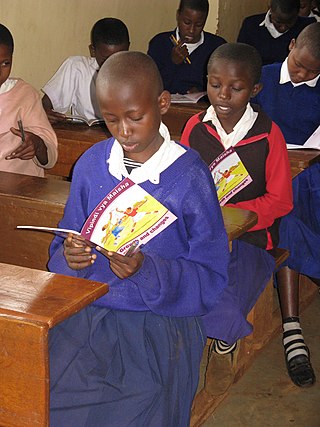
Sanitation refers to public health conditions related to clean drinking water and treatment and disposal of human excreta and sewage. Preventing human contact with feces is part of sanitation, as is hand washing with soap. Sanitation systems aim to protect human health by providing a clean environment that will stop the transmission of disease, especially through the fecal–oral route. For example, diarrhea, a main cause of malnutrition and stunted growth in children, can be reduced through adequate sanitation. There are many other diseases which are easily transmitted in communities that have low levels of sanitation, such as ascariasis, cholera, hepatitis, polio, schistosomiasis, and trachoma, to name just a few.

Sewerage is the infrastructure that conveys sewage or surface runoff using sewers. It encompasses components such as receiving drains, manholes, pumping stations, storm overflows, and screening chambers of the combined sewer or sanitary sewer. Sewerage ends at the entry to a sewage treatment plant or at the point of discharge into the environment. It is the system of pipes, chambers, manholes, etc. that conveys the sewage or storm water.

The miasma theory is an abandoned medical theory that held that diseases—such as cholera, chlamydia, or the Black Death—were caused by a miasma, a noxious form of "bad air", also known as night air. The theory held that epidemics were caused by miasma, emanating from rotting organic matter. Though miasma theory is typically associated with the spread of contagious diseases, some academics in the early nineteenth century suggested that the theory extended to other conditions as well, e.g. one could become obese by inhaling the odor of food.

Sir Edwin Chadwick KCB was an English social reformer who is noted for his leadership in reforming the Poor Laws in England and instituting major reforms in urban sanitation and public health. A disciple of Utilitarian philosopher Jeremy Bentham, he was most active between 1832 and 1854; after that he held minor positions, and his views were largely ignored. Chadwick pioneered the use of scientific surveys to identify all phases of a complex social problem, and pioneered the use of systematic long-term inspection programmes to make sure the reforms operated as planned.

Sanitary engineering, also known as public health engineering or wastewater engineering, is the application of engineering methods to improve sanitation of human communities, primarily by providing the removal and disposal of human waste, and in addition to the supply of safe potable water. Traditionally a branch of civil engineering and now a subset of environmental engineering, in the mid-19th century, the discipline concentrated on the reduction of disease, then thought to be caused by miasma. This was accomplished mainly by the collection and segregation of sewerage flow in London specifically, and Great Britain generally. These and later regulatory improvements were reported in the United States as early as 1865.
Water supply and sanitation in the United States involves a number of issues including water scarcity, pollution, a backlog of investment, concerns about the affordability of water for the poorest, and a rapidly retiring workforce. Increased variability and intensity of rainfall as a result of climate change is expected to produce both more severe droughts and flooding, with potentially serious consequences for water supply and for pollution from combined sewer overflows. Droughts are likely to particularly affect the 66 percent of Americans whose communities depend on surface water. As for drinking water quality, there are concerns about disinfection by-products, lead, perchlorates, PFAS and pharmaceutical substances, but generally drinking water quality in the U.S. is good.
Access to at least basic water increased from 94% to 97% between 2000 and 2015; an increase in access to at least basic sanitation from 73% to 86% in the same period;
Drinking water and sanitation in Nicaragua are provided by a national public utility in urban areas and water committees in rural areas. Despite relatively high levels of investment, access to drinking water in urban areas has barely kept up with population growth, access to urban sanitation has actually declined and service quality remains poor. However, a substantial increase in access to water supply and sanitation has been reached in rural areas.
The water and sanitation sector in Peru has made important advances in the last two decades, including the increase of water coverage from 30% to 85% between 1980 and 2010. Sanitation coverage has also increased from 9% to 37% from 1985 to 2010 in rural areas. Advances have also been achieved concerning the disinfection of drinking water and in sewage treatment. Nevertheless, many challenges remain, such as:

Charles Value Chapin was an American pioneer in public health research and practice during the Progressive Era. He was superintendent of health for Providence, Rhode Island between 1884 and 1932. He established one of the earliest municipal public health laboratories in 1888, and the Providence City Hospital for contagious diseases in 1910. Chapin taught at Brown University and Harvard. In 1927 he served as president of the American Public Health Association and as the first president of the American Epidemiological Society.
Water supply and sanitation in China is undergoing a massive transition while facing numerous challenges such as rapid urbanization, increasing economic inequality, and the supply of water to rural areas. Water scarcity and pollution also impact access to water.

The water supply and sanitation sector in Ghana is a sector that is in charge of the supply of healthy water and also improves the sanitation of water bodies in the country.
Drinking water supply and sanitation in Pakistan is characterized by some achievements and many challenges. In 2020, 68% Pakistanis, 72% Indians, 54% Bangladeshi had access to the basic sanitation facilities. Despite high population growth the country has increased the share of the population with access to an improved water source from 85% in 1990 to 92% in 2010, although this does not necessarily mean that the water from these sources is safe to drink. The share with access to improved sanitation increased from 27% to 38% during the same period, according to the Joint Monitoring Program for Water Supply and Sanitation. There has also been considerable innovation at the grass-root level, in particular concerning sanitation. The Orangi Pilot Project in Karachi and community-led total sanitation in rural areas are two examples of such innovation.

A sanitation worker is a person responsible for cleaning, maintaining, operating, or emptying the equipment or technology at any step of the sanitation chain. This is the definition used in the narrower sense within the WASH sector. More broadly speaking, sanitation workers may also be involved in cleaning streets, parks, public spaces, sewers, stormwater drains, and public toilets. Another definition is: "The moment an individual’s waste is outsourced to another, it becomes sanitation work." Some organizations use the term specifically for municipal solid waste collectors, whereas others exclude the workers involved in management of solid waste sector from its definition.

The history of water supply and sanitation is one of a logistical challenge to provide clean water and sanitation systems since the dawn of civilization. Where water resources, infrastructure or sanitation systems were insufficient, diseases spread and people fell sick or died prematurely.

Swachh Bharat Mission, Swachh Bharat Abhiyan, or Clean India Mission is a country-wide campaign initiated by the Government of India on 2 October 2014 to eliminate open defecation and improve solid waste management and to create Open Defecation Free (ODF) villages. The program also aims to increase awareness of menstrual health management. It is a restructured version of the Nirmal Bharat Abhiyan which was launched by the Congress in 2009 that failed to achieve its intended targets due to rampant corruption and indecisive leadership.
Lesotho is a mountainous and fairly 'water-rich country', but suffers from a lack of clean drinking water due to inadequate sanitation. In recent decades, with the construction of dams for the Lesotho Highlands Water Project (LHWP), Lesotho has become the main provider of water to parts of northern South Africa. Despite the economic and infrastructure development occasioned by the LHWP, waterborne diseases are common in the country and the infant mortality rate from them is high. In 2017, a project to improve the rural water supply in the Lesotho Lowlands was funded by the Global Environment Facility and the African Development Bank, and is ongoing.

Socialhousekeeping, also known as municipal or civil housekeeping, was a socio-political movement that occurred primarily through the 1880s to the early 1900s in the Progressive Era around the United States.

Menstrual hygiene management (MHM) or menstrual health and hygiene (MHH) refers to access to menstrual hygiene products to absorb or collect the flow of blood during menstruation, privacy to change the materials, and access to facilities to dispose of used menstrual management materials. It can also include the "broader systemic factors that link menstruation with health, well-being, gender equality, education, equity, empowerment, and rights". Menstrual hygiene management can be particularly challenging for girls and women in developing countries, where clean water and toilet facilities are often inadequate. Menstrual waste is largely ignored in schools in developing countries, despite it being a significant problem. Menstruation can be a barrier to education for many girls, as a lack of effective sanitary products restricts girls' involvement in educational and social activities.












